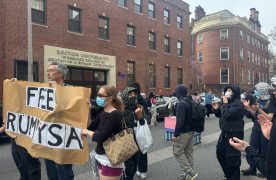Content Warning: This article includes discussions of racial violence and police brutality
The acquittal of Kyle Rittenhouse — the white man who murdered two people at the protests in Kenosha, Wisconsin in August 2020 — is a product of the American criminal justice system working as designed — as a system built on protecting and perpetuating white supremacy.
Jacob Blake was 29 years old when he was shot by a white police officer in 2020. He was shot multiple times in the back in front of his children, and is now paralyzed from the waist down.

Rusten Sheskey, the officer who shot Blake, was cleared of charges by Wisconsin prosecutors in January 2021 on the basis that Sheskey was acting in self-defense because Blake had a knife. Sheskey — a police officer trained to respond to tense situations and armed with a gun — claimed he feared for his life because Blake had a pocket knife.
In response to the police shooting of Jacob Blake, people in Kenosha protested. An emergency curfew was set, and police fired tear gas and rubber bullets into the crowds. During the protests, Rittenhouse travelled from his home state of Illinois to Kenosha armed with an AR-15-style rifle. He claims he went to Kenosha to act as a medic and to protect private property.
Eleven months after Sheskey was acquitted, Kyle Rittenhouse was acquitted on the basis that he was acting in self-defense.
Rittenhouse walked into a protest with an AR-15-style rifle, and killed two people. Rittenhouse claimed he killed Joseph Rosenbaum because Rosenbaum was chasing him. Rittenhouse murdered Huber because Huber struck him with a skateboard.
The Wisconsin self-defense law places the burden of proof on the prosecution to prove that Rittenhouse was not acting in self-defense, even if he was deemed to be the first aggressor in the incident.
It is clear from Sheskey’s and Rittenhouse’s cases that self-defense laws have a history of allowing murderers to walk free. If these laws have a history of allowing white men to commit violence with impunity, then is the Rittenhouse trial an example of the criminal justice system not functioning as it should be, or is this system functioning exactly as it was designed?
Self-defense laws were utilized as tools to protect white supremacy. Harvard University historian Caroline Light found in her research that though self-defense laws were rooted in English common law principles, they were then significantly modified in the late 19th century to mainly protect white men and their possessions or property.
After the Civil War, certain codes and laws banned Black people from possessing weapons. Black people also did not have full access to citizenship at this time, meaning that the legal protections in self-defense were not offered to them.
The Rittenhouse case is not the first time self-defense laws were utilized to allow a murderer to walk free.
In 2012, 17-year-old Trayvon Martin was murdered by George Zimmerman. Zimmerman was allowed to walk free due to stand-your-ground laws. As Light explains in an interview with the Harvard Gazette, the jury “believed that it was reasonable for Zimmerman to fear for his life when he saw an unarmed Black teenager. I think that speaks volumes to the pernicious injustice of stand-your-ground laws.”
From this, it is clear that the Rittenhouse verdict is not an isolated case of injustice, but an example of what criminal justice was designed to do. The laws in place do not allow for actual punishment to be carried out to white supremacists because it was designed to protect white supremacists.
Rittenhouse’s acquittal was aided by many factors beyond the structure of the criminal justice system. As Boston University School of Law Dean Angela Onwuachi-Willig explains in a BU Today interview, Rittenhouse’s expensive legal defense team gave him many tangible advantages.
His whiteness and youth also contributed to how the jury perceived him as innocent. By contrast, in 1989, the Central Park Five, who were a group of five Black and Hispanic teenagers, were tried as adults for a crime they did not commit. It took years for them to be released, and they still live with the trauma of their time in jail.
It seems we are confronted with the racist nature of the structures that created this country every day, bringing us to question what we can do. Should we amend Wisconsin’s self-defense laws? Should we impose stronger gun laws to prevent people like Rittenhouse from accessing a weapon in the first place? Is any of this even possible?
It is important to note the entire system is enmeshed in racist violence and reverberates beyond Rittenhouse. If the foundation is flawed, then the entire endeavor of justice is doomed for failure.
The conversation surrounding the abolition of our current criminal justice system is incredibly difficult to have when one cannot picture a world that isn’t tied to the criminal justice system. Reading about a world without police and working with community based-efforts will help in better conceptualizing these possibilities.
Nonetheless, the Rittenhouse verdict is proof that the criminal justice system cannot be easily fixed. In fact, it is doing what it was designed to do all along.














